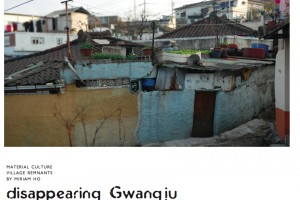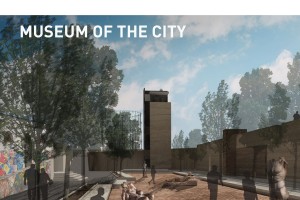RePost (Regarding Exhibition Publication Opportunities) features ongoing work by Waterloo Architecture students, faculty, and alumni that has been exhibited, published, or presented in other venues. This series starts up again with an article by former Director and current Associate Professor Rick Haldenby, as well as Lorenzo Pignatti, Associate Professor and Associate Director of the Rome Program. It originally appeared in English and Italian in the February issue of Domus. We welcome submissions at bridge@waterlooarchitecture.com.
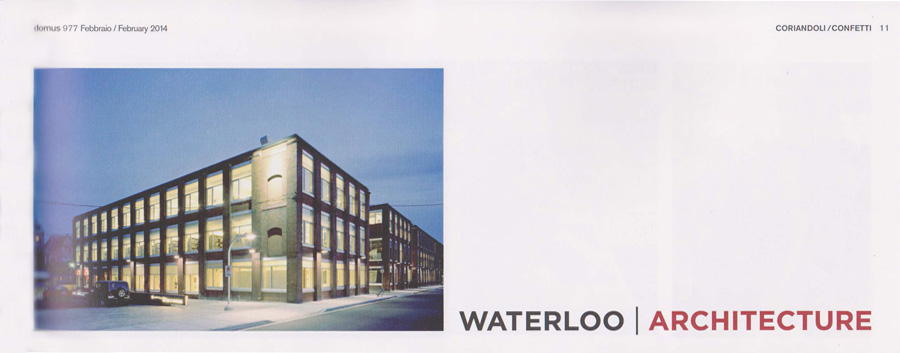
The School of Architecture is a fertile home for student initiative. From its foundation in 1967 the School of Architecture has been driven by three complementary characteristics. Waterloo is a co-op school: beginning in second year, all undergraduate students spend each alternate term working in the field of architecture and design, throughout their professional education. They work for periods of four or eight months between academic terms, and the work is paid. Virtually all jobs are in private architectural practices, and more than a third of the jobs are with firms outside Canada. The network is substantial, and shifts constantly with the market and student interest. At any given moment students are working in 40 to 50 different cities on 5 different continents. The network of connection and conversation involves the school with the practice and discipline of architecture at a global scale. While Waterloo operates on the principle that there is no gap between education and practice, it does not simply train practitioners. From the outset the school presents architecture as a cultural praxis and a field of cultural speculation. The strength of the Cultural History Programme and the fact that the first half of fourth year takes place at the school’s campus in Rome – and has done so for the past 35 years – reflects the commitment to provide a serious conceptual and critical foundation that allows our students to situate their work in broader social, intellectual and cultural fields. This makes it possible, in the graduate programme, to present students with virtually complete freedom to choose their specific field of research and design. The independence and ambition of the work is remarkable.
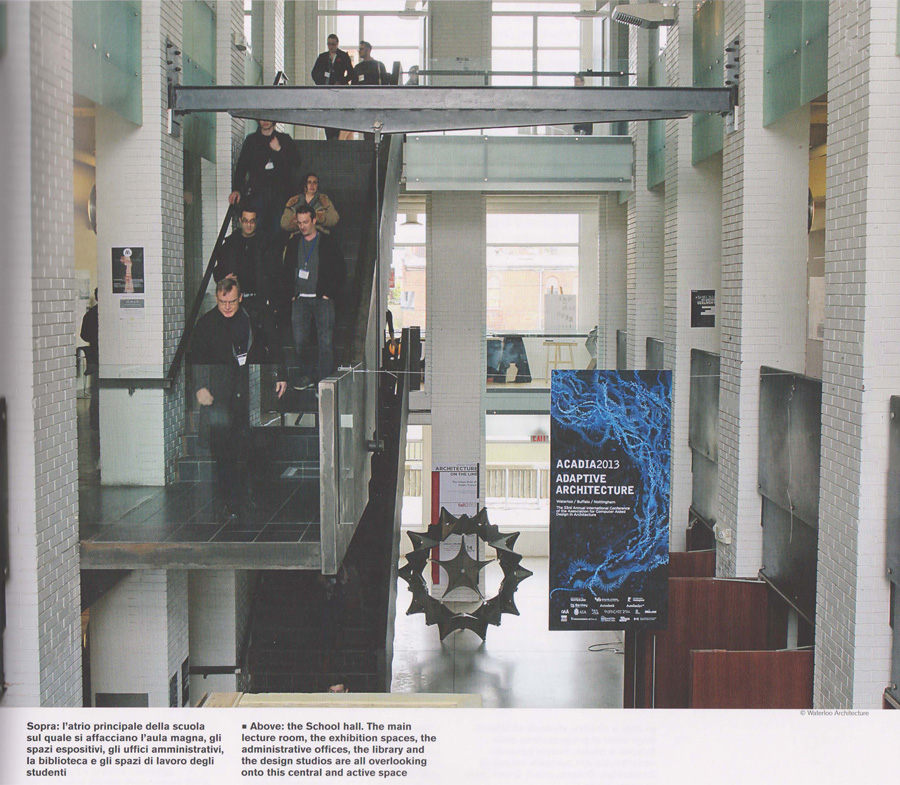
The third condition has to do with the location, or rather relocation of the school. In 2001 the faculty, staff and students of the School and the University of Waterloo decided to accept the invitation of the City of Cambridge, Ontario to relocate Architecture to a satellite location, about 30 kilometres from the main campus. The City of Cambridge, which sits astride the busiest transportation corridor in North America, was prosperous and growing – but its core area, one of the most beautiful urban landscapes in Canada, was in a slow state of decline. The relocation of the School of Architecture drew financial support from the municipal, provincial and federal governments. It attracted support from individuals, foundations and the business community. The community adopted the school as the main agent for the revitalisation of the urban core. The press and other institutions promoted the arrival of the school as the most important cultural development in the entire region . The relocation of the School of Architecture to a century-old former silk mill on the west bank of the Grand River in the historic core of Galt has produced extraordinary transformations to both school and city. The number of housing units in the Galt core has tripled (1,015 to 3,500), including a housing co-op that was conceived, designed, constructed and operated by architecture students. After completing the School of Architecture the city constructed an award-winning City Hall and embarked on an ambitious cultural programme, building a Civic Theatre and production facilities . The city recently purchased the historic 1885 Galt Post Office and is renovating the nationally listed historic building as part of the enterprising conversion of its system of libraries and art galleries into a network of centres of information and creative production, branded The Idea Exchange. Four Waterloo faculty members have been named winners of the Canada Council for the Arts Prix de Rome: Dereck Revington, Philip Beesley, John McMinn and Lola Sheppard. Waterloo professors have represented Canada at the Venice Biennale twice, John McMinn in 2008 and Philip Beesley in 2010. In 2014 the Canadian Pavilion at the Biennale will be co-curated by Lola Sheppard on the theme Arctic Adaptations.
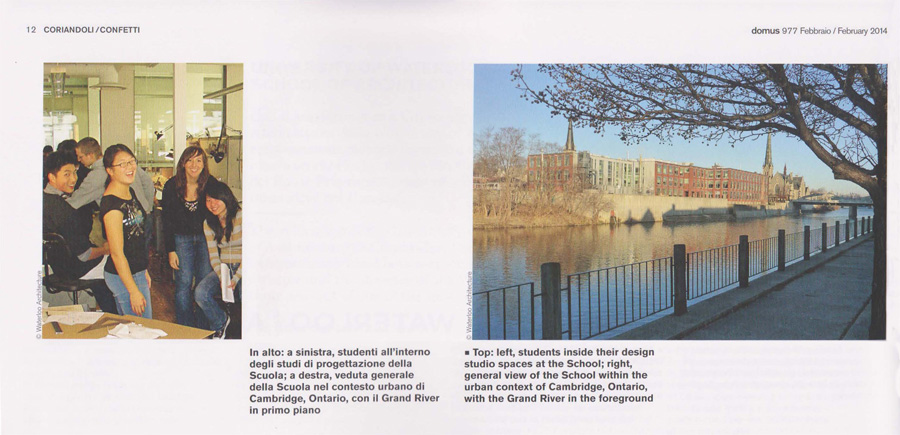
The School of Architecture is a founding partner and the home of Design at Riverside, a gallery operated by Cambridge Galleries and curated by members of the gallery and the school. It is one of only two publically funded galleries in Canada dedicated exclusively to architecture and design. Design at Riverside represents one of a series of partnerships by which the School of Architecture and the Cambridge community are intimately connected. In addition to the gallery, the school also houses a cafe that serves as a platform for the engagement of the student body and the community. All told some 180,000 people visit the School of Architecture building every year: it is a key point of interest, focus and pride in the community.
The spirit of outreach and partnership began with the invitation to relocate to Cambridge and was expressed in the city providing almost $9,500,000 and obtaining an additional $8,200,000 in provincial and federal funding, creating Design at Riverside, and incorporating the school and its programmes into the City’s Economic Development Plan, Heritage Master Plan and Arts and Culture Master Plan . The School of Architecture hosted the Cambridge Festival for the Arts and the inaugural Grand River Film Festival. Students have done dozens of design and research projects sited in the Galt core . They have created installations and media projects for civic festivals, staged events and created installations that engage the community to reflect on the public spaces, culture and quality of life in the city. In general the projects and installations have aimed at provoking reflection on the possibilities of enlivening urban space, economy and culture. Projections, animations, instant parks and beaches, projects for theatres, markets and hotels all present a city that could easily be.
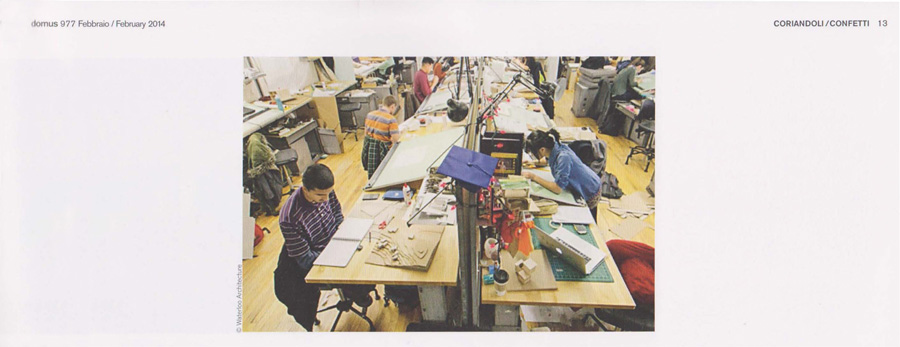
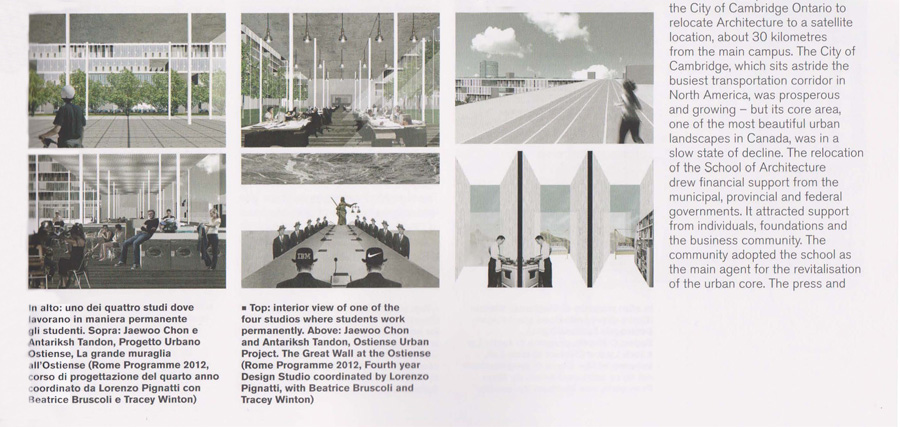
The Honours Bachelor of Architectural Studies degree provides the foundation of skills, knowledge, judgment and practical experience required for subsequent professional studies in architecture. Though the academic plan is pre-professional, it is fully dedicated to imparting the culture and practice of design to students. Design is a synthetic activity: to do it well and serve the needs of the individual and society requires an extremely broad education. Students acquire an understanding of the workings of society and culture, of the principles of physics, of materials and techniques of construction, of human interaction with the natural and built environment, of historical process, of critical thought and of the diverse forms of creative expression.
The University of Waterloo offers a graduate programme leading to the Master of Architecture degree, for professional qualification as architects. The master’s programme in architecture combines elements of a professional master’s and a research-oriented masters programme. It offers preparation for entry into the architecture profession (together with an extension of the knowledge-base required of practicing professionals, current and future) to students with an undergraduate degree in pre-professional architecture, such as a Bachelor of Architectural Studies. The programme is designed to develop the skills and intellectual curiosity required for a leadership role in the profession and in society, and for entry into doctoral studies. The master’s thesis, the core academic component of the programme, develops research and analytical/interpretive skills, as well as design skills, i.e. the synthetic skills of architecture.
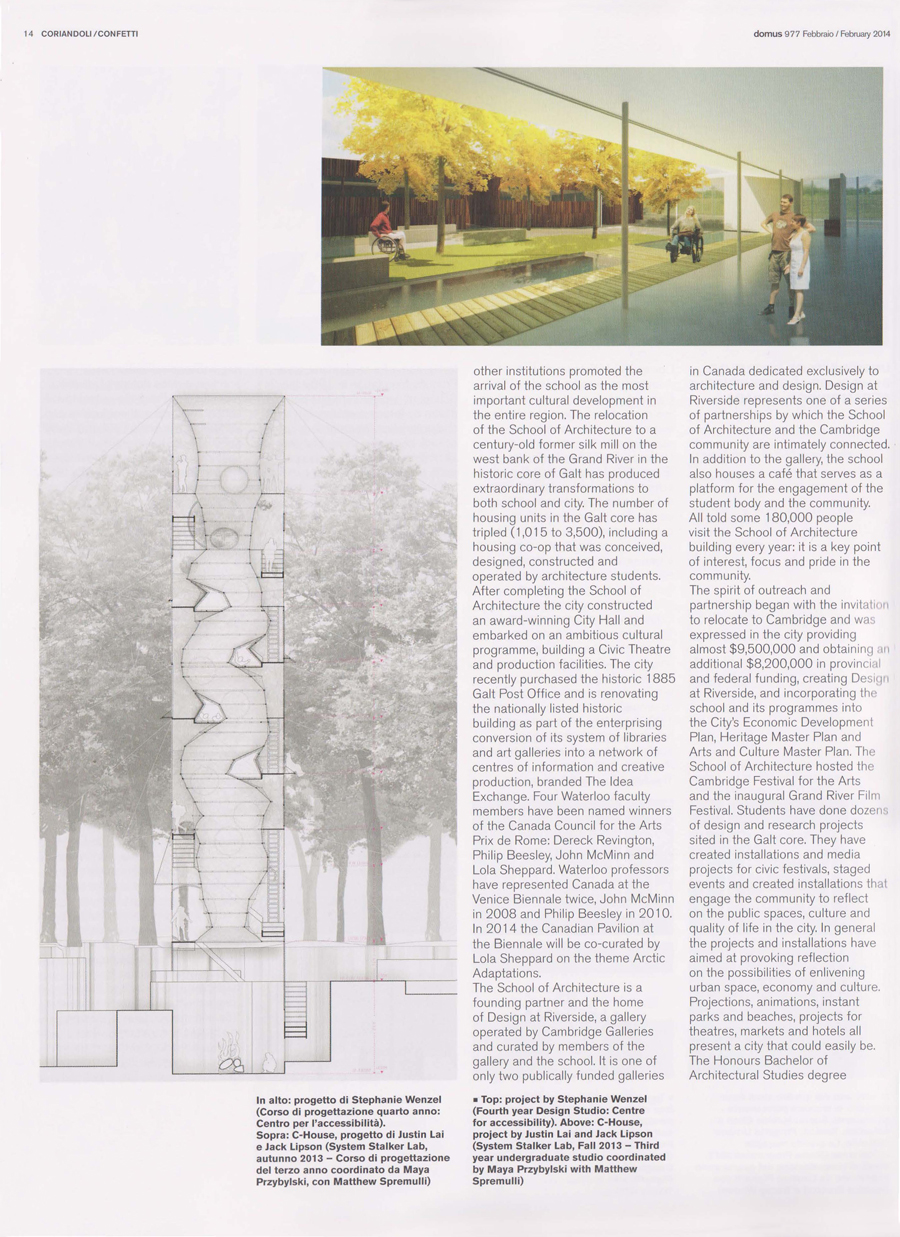
Co-op Programme
Co-operative education is one of the keystones of the architecture programme at the University of Waterloo. Beginning in second year, students alternate four-month school terms with four-month paid co-op terms working for architects and designers. The co-operative programme allows students to personally experience the nature and variety of the work the profession offers . Co-op terms also make it possible to acquire a wide array of specific skills, discipline and experience, which complements the more exploratory and speculative work that goes on in the Design Studio programme.
The Rome Programme
The University of Waterloo established a study-abroad programme in Rome in 1979, in the same years as the “Roma lnterrotta” exhibition at the Forum of Trajan and the “Presenza del Passato with the Strada Nuovissima” at the Venice Biennale. These events stressed the importance of looking at history and the past as a major source of design inspiration. From that cultural position, the University of Waterloo sought to open a field wherein students could develop a critical discourse about architectural design and enrich their learning experience, through living and studying in a city like Rome. The Rome Programme has evolved since then, following the cultural and social shifts of the architectural and urban disciplines, and over the years has confronted issues related to cultural sites, urban design, landscape, transportation, environment and sustainability. The design work has always addressed Rome’s historic and archaeological sites, searching to establish a relationship between the historic city and new transformations, as well as between ancient and historic artifacts and contemporary hybrid urban typologies . In the general curriculum of the School of Architecture, the Rome Programme is regarded as a significant moment: confronting the notion of urbanity from within a physical and cultural context of great significance. Rome is certainly a lesson in architecture and urbanism that can illustrate and present the relationship between urban morphology and architectural typology, and offers the challenge of designing within a dense, layered and particular urban context.
The Design Studio in Rome is thus structured around the critical relationship between design and context, as a paradigm for contemporary design. By trying to avoid self-referential solutions or object buildings, the work of the Studio is consistently oriented towards the search of this relationship and the creation of a strong dialogue between the forma urbis of the city (both physical and metaphorical) and the new architecture that would be contained in it.
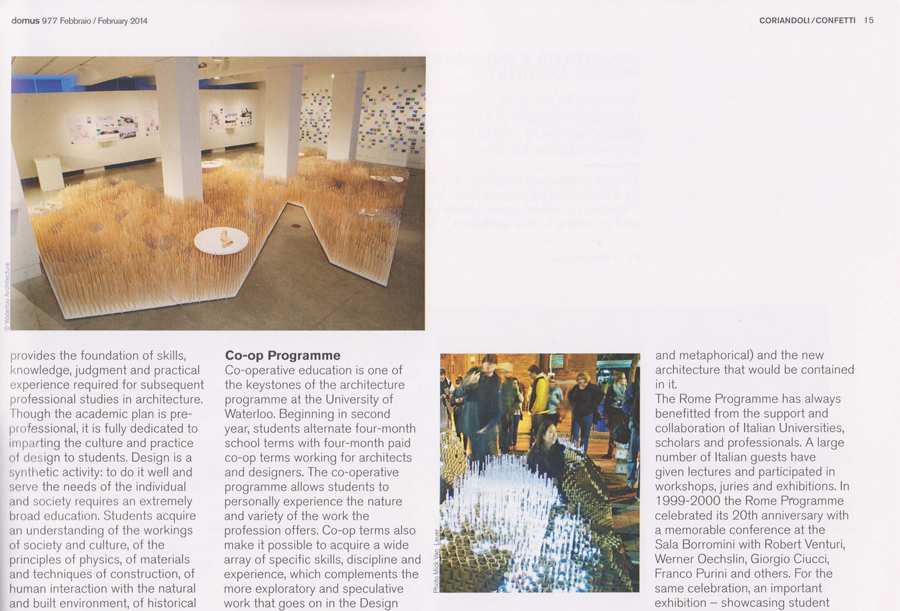

The Rome Programme has always benefited from the support and collaboration of Italian Universities, scholars and professionals. A large number of Italian guests have given lectures and participated in workshops, juries and exhibitions. In 1999-2000 the Rome Programme celebrated its 20th anniversary with a memorable conference at the Sala Borromini with Robert Venturi, Werner Oechslin, Giorgio Ciucci, Franco Purini and others. For the same celebration, an important exhibition – showcasing student projects done in Rome alongside work by prominent Italian architects – took place at Toronto’s BCE gallery.
The Rome Programme has also established formal institutional agreements with both the Facolta di Architettura at Roma 3 and with the Facolta di Architettura at Pescara. With Roma 3 the exchange developed through partnership in the Architettura | Storia | Progetto Masters, founded by Mario Maniera Elia and now directed by Francesco Cellini and Maya Segarra Lagunes . Links with the University of Pescara developed via a series of shared research projects for different cities of the Adriatic Region (Pescara, Rijeka, Duress and Split) with the support of the Musagetes Foundation of Canada.
Through both these relationships, Italian students and professors have been able to visit and study in Canada, as Waterloo students have in Italy. These exchanges have been very fruitful to students and teachers alike, and have produced common research topics, shared projects and several publications.
University of Waterloo
School of Architecture at Cambridge
Studenti/Undergraduate students
290
Studenti di master/Graduate students
86
Membri della facoltà/Faculty members
60
Personale/Staff
12
Domande di ammissione/Students that apply
Studenti/Undergraduate
1,392
Post laurea/Graduate
67
Studenti ammessi/Students accepted
77
Strutture/Facilities
Sale conferenze/Lecture rooms
L.A. Cummings Lecture Hall
250 m2 , 210 posti/seats
E-Classroom
150 m2, 81 posti/seats
Studi di progettazione/Design studios
2,568 m2, 308 postazioni lavoro/workstations
Galleria espositiva/Exhibition gallery, Design at Riverside
450 m2
Spazio espositivo/Exhibition space, Stantec Architecture Gallery
100 m2
Laboratori/Workshops
Fabrication Lab: 450 m2 (falegnameria, fonderia, fabbricazione digitate/traditional wood and metal working, digital fabrication)
Christie Digital Media Centre: 260 m2
Informatica, video digitate, fotografia, studio di registrazione, negozio, tipografia/Computer lab, digital video lab, photography studio, sound studio, supply store, printing shop
Spazi ausiliari/ Auxiliary spaces
Palestra/Fitness room
90 m2
Melville Cafe
240 m2
Biblioteca Musagetes/Musagetes Library
1,300 m2 , 24,000 volumi/volumes, 77 riviste/ journals, strutture GIS/GIS facilities, 700 video/film titles
Rome Studio
piazza Santa Apollonia 3, Roma/Rome, Italy
Spazio didattica/Studio space
550 m2
Sala conferenze/Lecture room
60 posti/seats
Biblioteca/Library
50 m2


